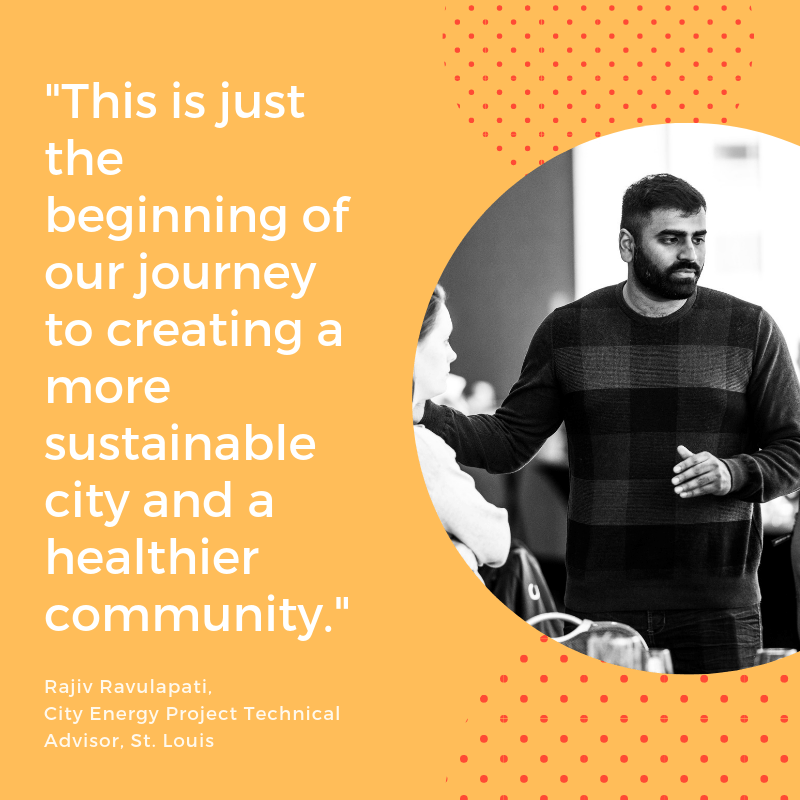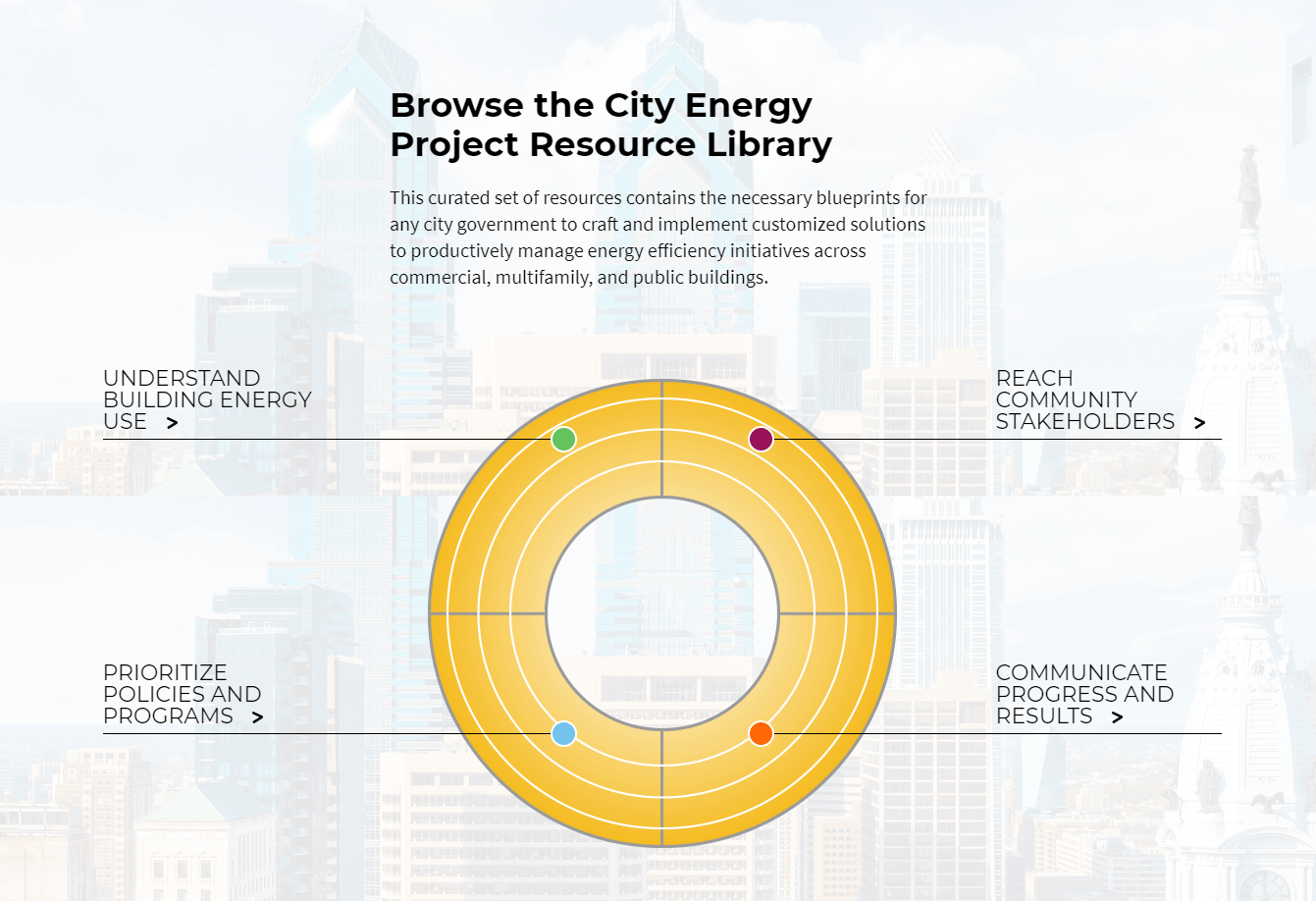What does it take to drive market transformation toward bigger, faster, deeper investments in energy efficiency? To figure this out, the City Energy Project, a national initiative from IMT and the Natural Resources Defense Council, embedded staff in 20 participating cities across the U.S. with a focus on boosting energy efficiency in buildings. These City Advisors help ensure that the energy efficiency efforts pursued by a city are customized to best meet local needs to maximize returns.
Meet Rajiv Ravulapati, the City Energy Project Technical Advisor for the City of St. Louis. A native of Chicago, Rajiv studied Environmental Science at Loyola University and worked in environmental advocacy with the Sierra Club before becoming joining City Energy Project.

What drew you to environmental work?
Growing up in Chicago, and my parents used to take me to the zoo a lot. Early on, I had a love of animals and natural spaces, and had thought I would go to college to become a zoologist. However, as I continued my studies, I realized that humans were the biggest danger to the planet and the animals that populate it, including themselves.
Now, I’ve been working in clean energy and energy efficiency for almost a decade. I do this work because I want to impact the broader picture of environmentalism and the best way I’ve found is to figure out how we can make our buildings more efficient and our planet safer.
What excites you most about the City Energy Project?
It’s inspiring to know that there are many people nationwide working to improve their cities and counties through energy efficiency and benchmarking. The City Energy Project provides me with a network of passionate peers in other cities nationwide.
In St. Louis, I love the problem-solving aspect of my work. Here, buildings are responsible for nearly 80% of greenhouse gas (GHG) emissions. We have more than 1,100 buildings covered by our benchmarking ordinance; working to optimize and streamline the process has been an exciting challenge. I am also a data-driven person, so I really enjoy creating and analyzing data maps for the project.
You mentioned that you really value the network of city advisors and city engagement managers that the City Energy Project has provided to you. Do you have any anecdotes or examples of a time you collaborated with someone else?
The City Energy Project’s Phase One cities are a great resource because they have been executing benchmarking ordinances for several years now. In St. Louis, we can learn from their best practices and mistakes to make the execution of our ordinance as successful as possible. Lately, I have been talking to Katrina Managan in Denver to learn more about their benchmarking compliance tracking system and how they achieved such a high compliance rate. Thanks to our collaboration with Denver, we now have robust data-quality checkers in place. With the help of other CEP cities, we are continuing to optimize our administrative benchmarking console and figure out new ways to make compliance more seamless and digitized.
Day to day, how would you describe your job?
Day to day, my duties include educating building owners about the ordinance and the how energy efficiency benefits their occupants and the greater community. I also coordinate with stakeholders from different city organizations, nonprofits, and institutions of higher education to increase participation in energy efficiency programs and maintain the levels of engagement that we’ve had.
Who are some of your collaborators, and do you have any examples of projects you’ve completed together?
Last summer, I established a robust Benchmarking Implementation Advisory Group to help provide outside input and recommendations on the Building Division’s implementation, compliance, and enforcement strategies. In addition to that valuable information, our stakeholders also give us their thoughts on how the city can better provide and push energy efficiency incentives, financing, and other options to businesses and building owners. This group is quite diverse and includes partners such as our Mayor’s Office, Office of Sustainability, various energy efficiency consultants, engineering firms, Spire Energy (gas utility), Ameren Missouri (electric utility), the International Facility Management Association (IFMA), the Building Owners and Managers Association (BOMA), the Institute of Real Estate Management (IREM), the Facilities Division of St. Louis, energy efficiency non-profits, and other community members.
Our utility providers have been fantastic partners. Ameren Missouri has been working side by side with the city to push energy efficiency options to businesses and building owners in St. Louis. Right now, Ameren and Spire both provide whole-building aggregate data for multitenant/multifamily building owners. This streamlines data entry in Portfolio Manager and therefore compliance with St. Louis’ benchmarking ordinance. Starting in 2019, customers will be allowed to verify multiple electric accounts associated with a single facility and automatically upload the monthly aggregated usage data directly into Portfolio Manager. This major step forward would not have happened without the continued outreach of the U.S. Green Building Council-Missouri Gateway Chapter and the City of St. Louis’ Building Division working together.

What were some of the biggest projects you’ve worked on during your tenure as a City Energy Project Advisor?
The three biggest opportunities I took on were educating the community about the ordinance and the benefits of benchmarking, partnering with utilities to make whole-building energy data available, and managing compliance with the ordinance.
Can you elaborate?
St. Louis created an education campaign to inform people about the ordinance, how to comply, and the benefits of benchmarking and energy efficiency. The city held training sessions for building owners where they could learn how to use Portfolio Manager, and now offers an energy efficiency concierge service and a website dedicated to technical assistance and benchmarking resources.
Our partnership with our local utility relied a great deal on community engagement. We started off by engaging frequently with the utility and acquiring testimony from building owners requesting access to their performance data. The city was presenting the needs of the community to our utilities, and now they are some of our strongest supporters.
More information about St. Louis’ benchmarking program, resources for compliance, and information on energy improvement financingcan all be found at stlbenchmarking.com
What advice would you have for other cities interested in becoming more sustainable?
Educate the community on the benefits of benchmarking for your city. Not only is it good for reducing energy consumption, building benchmarking has non-energy benefits on public health and the economy. It is also important to have community support. In particular, have the support of your mayor’s office or your sustainability office and the top 15–20 buildings that use the most energy. Backing or letters of support from your local utility can also be very helpful.
What are some of the most rewarding moments you’ve had as a city advisor?
The city’s mandatory benchmarking activities uncovered three municipal buildings that had ENERGY STAR scores over 75, including our city hall. When we found out, we pursued ENERGY STAR certification, and they were all approved. It’s great to see how the city can lead the charge on energy efficiency, especially within our very own ENERGY STAR-certified city hall.
St. Louis and the City Energy Project were also recognized with the 2017 Outstanding Local Government Achievement Award for Exemplary Public/Non-Profit Collaboration from the East-West Gateway Council of Governments for our work promoting energy efficiency in buildings, protecting public health, reducing energy costs, and preparing for the impacts of climate change.
Facilitating St. Louis’ support and collaboration with other groups in our community has been a very rewarding process. Right now, we are collaborating with the USGBC to provide Green Professionals (GPRO) Building Skills Training to city staff and other St. Louis professionals. Our outreach and education efforts have inspired businesses and building owners to seek improvements in their properties. Through connections made as part of the City Energy Project, we were able to learn of and encourage the St. Louis Development Corporation (SLDC) to apply for the Institute for Market Transportation’s Small Business Energy Initiative (SBEI) program. SLDC was accepted as a participant and now can offer free energy audits to the St. Louis community!
So far, six businesses have applied for SLDC’s free energy audits, including a local restaurant called Kounter Kulture. As they complete the audit process, they also plan on applying for PACE financing to get the capital to install an energy-efficient roof.
Starting in 2019, four municipal buildings will undergo retrocommissioning over the course of 18 months. Our Facilities Commissioner, Rick Ernst, was approved for a $1.3 million loan from the Missouri Division of Energy. The total projected annual savings is over $500,000 with an overall payback period of just 2.7 years. The four buildings are our City Justice Center, SLMPD Headquarters (new), Juvenile Courts Center, and Carnahan Courthouse. As a Technical Advisor, this is a moment that is quite rewarding because it continues to prove that St. Louis is committed to improving their own building stock. Leading by example is crucial in getting private-sector buildings to understand the benefits of investing in their own buildings.”
Another exciting outcome of the project was the transition of the Technical Advisor position to a permanent position within the city government. Though we are only in year two of implementation, the benchmarking ordinance and the groundwork it is laying for future improvement and sustainable development in St. Louis has proven itself to be valuable to the community. I’m excited to say that this is just the beginning of our journey to creating a more sustainable city and a healthier community.

The City Energy Project is a national initiative to create healthier, more prosperous American cities by improving the energy efficiency of buildings. The pioneering actions taken by the 20 participating cities are now distilled in a cured yet comprehensive City Energy Project Resource Library, a must-use tool for any jurisdiction on how to leverage energy efficiency to reach ambitious climate, economic, and social goals. Learn more at cityenergyproject.org.
